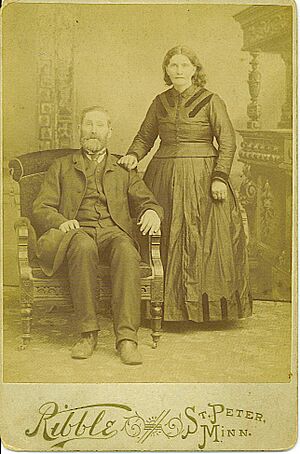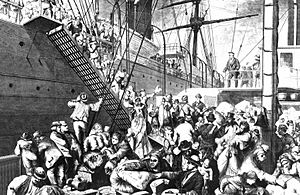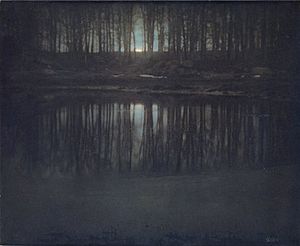Luxembourgish Americans facts for kids
| Total population | |
|---|---|
| 47,129 (2019) | |
| Regions with significant populations | |
| Illinois · Wisconsin · Michigan • Minnesota · Iowa · California · South Dakota · Ohio · Pennsylvania · New York · Florida · Indiana · Kansas · Missouri | |
| Languages | |
| American English · Luxembourgish · German · French | |
| Religion | |
| Roman Catholicism · Judaism · Lutheranism | |
| Related ethnic groups | |
| German Americans · Belgian Americans · French Americans |
Luxembourgish Americans are people in the United States who have family roots from Luxembourg. Luxembourg is a small country in Europe. In 2000, about 45,139 Americans said they had full or partial Luxembourgish heritage. Many years ago, in 1940, there were even more, around 100,000 Americans with Luxembourgish family.
The first families from Luxembourg came to the U.S. around 1842. They were leaving their home country because there were too many people and not enough jobs. They often worked on farms, just like they did in Luxembourg.
Most Luxembourgish Americans live in the Midwest. This is where many of their ancestors first settled in the 1800s. In 2000, the states with the most Luxembourgish Americans were Illinois (6,963 people), Wisconsin (6,580), Minnesota (5,867), Iowa (5,624), and California (2,824).
History of Luxembourgish Immigration

Between the mid-1800s and early 1900s, about one-third of all people living in Luxembourg left their country. At that time, Luxembourg was a poor country. Most people worked in farming. The United States was a popular place for Luxembourgers to move, just like it was for many other Europeans. It's believed that about 60,000 to 70,000 Luxembourgers moved to the U.S. in the 1800s.
Many Luxembourgers started moving to America around 1845. There were several reasons for this. Better medicine meant more babies survived, which led to too many people living in Luxembourg. There weren't enough jobs in factories, and the country couldn't grow enough food for everyone.
Families at that time were often very large. When parents passed away, their land was divided among all their children. This meant each child got only a small piece of land, often not enough to feed their own family. So, some children would sell their small piece of land to an older brother. This money was then used to pay for the trip to America and start a new life there.

Traveling became easier during this time. News also reached Europe that there was a lot of empty land in America. The Homestead Acts offered good farmland for very low prices. Many people decided to take this chance for a new start. They knew that staying in Luxembourg might mean starvation.
When Luxembourgers arrived in the United States, they were sometimes listed as Belgians or Germans by the authorities. This was because Luxembourg is a small country located between Belgium, Germany, and France. After arriving in New York, most Luxembourgers moved on to places like Chicago, Iowa, Minnesota, and Wisconsin. Only a few stayed in New York.
In 1871, after the Great Chicago Fire, people from St. Michael's Church in Chicago created the first Luxembourgish-American group. It was called the Luxemburger Unterstützungsverein, which means Luxembourg Mutual Aid Society. Other groups followed, like the Luxembourg Bruderbund and the Luxembourg American Cultural Society. These groups helped Luxembourgers in America support each other.
Notable People of Luxembourgish Descent
Here are some famous people who have Luxembourgish ancestry:
- John W. Beschter (1763–1842) – A Jesuit missionary and a leader at Georgetown University.
- Chris Evert (born 1954) – A very famous tennis player who won 21 major tennis titles called Grand Slams.
- Red Faber (1888–1976) – A baseball player who is in the Baseball Hall of Fame.
- Hugo Gernsback (1884–1967) – An inventor and a writer known for his science fiction stories.
- Dennis Hastert (born 1942) – A Republican politician who used to be the Speaker of the United States House of Representatives, a very important job in the U.S. government.
- Theodore Hesburgh (1917–2015) – A priest and a well-known leader in education.
- Paul O. Husting (1866–1917) – A Democratic politician who served as a U.S. Senator for Wisconsin.
- Vincent Kartheiser (born 1979) – An actor famous for his roles in TV shows like Angel and Mad Men.
- Richard F. Kneip (1933–1987) – A Democratic politician who was once the Governor of South Dakota.
- Paul Lauterbur (1929–2007) – A chemist who won the Nobel Prize in Physiology or Medicine for his work.
- John L. May (1922–1994) – A leader in the Roman Catholic Church, serving as a Bishop and Archbishop.
- Arno Mayer (born 1926) – A historian and professor at Princeton University.
- Nicholas Muller (1836–1917) – A Democratic politician who was a United States Representative from New York.
- Gene Scholz (1917–2005) – A professional basketball player.
- Edward Steichen (1879–1973) – A famous photographer, painter, and art curator.
- Matthew Woll (1880–1956) – A leader in trade unions and a former Vice President of the AFL-CIO.
- Loretta Young (1913–2000) – An actress who won an Academy Award for Best Actress.
- Alex Wagner (born 1977) – A journalist and author.
See also
 In Spanish: Inmigración luxemburguesa en los Estados Unidos para niños
In Spanish: Inmigración luxemburguesa en los Estados Unidos para niños
- Luxembourg Brotherhood of America
- Luxembourgers
- Luxembourgian Brazilians
- Luxembourg–United States relations


